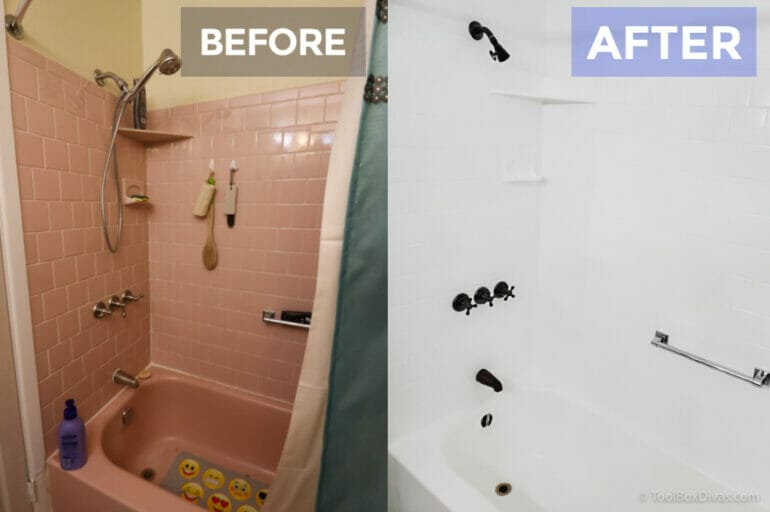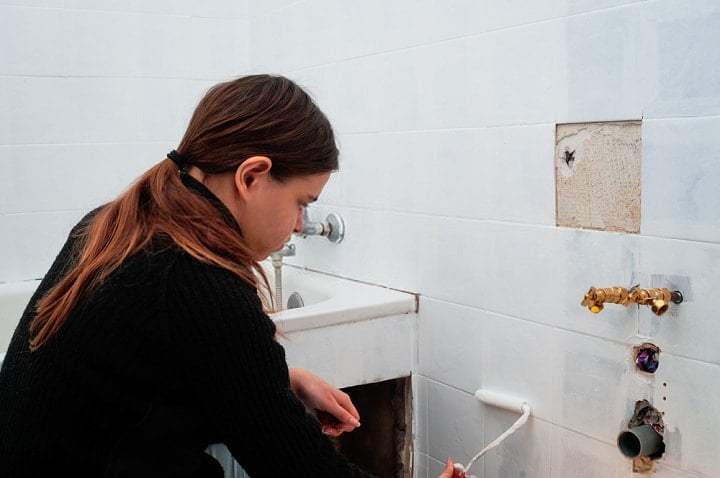If you’ve recently painted your bathroom, you might be wondering how long you should wait before taking a shower. It’s important to give the paint enough time to dry and cure properly to avoid any damage or smudging. Generally, it is recommended to wait at least 24 to 48 hours after painting before using the shower. This allows the paint to fully dry and harden, ensuring a long-lasting and flawless finish. However, always check the specific drying instructions mentioned on the paint can for the most accurate guidance.

Quick Tips for Drying the Paint in Your Bathroom Before Taking a Shower
When it comes to painting your bathroom, one of the most important things is to ensure that the paint is properly dried before using the shower. Wet paint can easily get damaged or smudged, leading to an unsightly finish. To help you speed up the drying process and achieve a beautiful, long-lasting paint job, here are some quick tips:
1. Choose the Right Type of Paint
Before you even start the painting process, it’s essential to choose a paint that is specifically designed for high-moisture areas like bathrooms. Look for paints labeled as moisture-resistant or bathroom paints. These types of paints are formulated to dry faster and withstand the damp environment of a bathroom.
2. Use Proper Ventilation
Proper ventilation is crucial for drying paint quickly. Open up windows and doors to allow fresh air to circulate in the bathroom. You can also use a fan or turn on the exhaust fan to help remove excess moisture from the room. Ventilation helps to speed up the evaporation process and ensures that the paint dries evenly.
3. Control Humidity Levels
Humidity can significantly impact the drying time of paint. Aim to keep the humidity level in your bathroom between 40% and 50% to facilitate faster drying. You can use a dehumidifier to remove excess moisture from the air. Alternatively, you can run a hot shower in another bathroom or the kitchen to create steam and draw moisture away from the freshly painted bathroom.
4. Avoid Taking Hot Showers
While it may be tempting to jump into a hot shower, doing so can prolong the drying process. Hot steam and water can soften the paint and cause it to become tacky or smudge. Opt for cooler showers or wait until the paint has completely dried before enjoying a steamy shower.
5. Give it Enough Time
Patience is key when it comes to drying paint. Even with the right type of paint, proper ventilation, and controlled humidity levels, the drying process takes time. Follow the manufacturer’s instructions on the paint can for drying times and wait for the recommended duration before using the shower. It’s better to wait a little longer to ensure a durable and flawless finish.
6. Avoid Contact with Water
While waiting for the paint to dry, be cautious about any water contact with the painted surfaces. Avoid splashing water or hanging damp towels on the freshly painted walls. Even minor exposure to water can compromise the drying process and result in streaks or smudges. Take extra care to prevent any accidental contact until the paint has fully cured.
7. Consider Using a Paint Accelerator
If you’re in a hurry to use your bathroom, you can consider using a paint accelerator product. These products are designed to speed up the drying time of paint. Follow the instructions provided with the accelerator and apply it according to the manufacturer’s recommendations. It can be a great solution when you’re short on time but still need your bathroom painted and ready to use quickly.
In summary, drying the paint in your bathroom before taking a shower requires some patience and proper preparation. Choose the right type of paint, ensure proper ventilation, control humidity levels, avoid hot showers, and give the paint enough time to dry. By following these quick tips, you can achieve a beautiful and durable paint finish in your bathroom.

Protecting your freshly painted bathroom from moisture
After spending time and effort on painting your bathroom, it’s important to take steps to protect the newly painted surfaces from moisture. Moisture can cause damage to the paint job, leading to peeling, bubbling, or discoloration. In this section, we will discuss some effective ways to safeguard your freshly painted bathroom from moisture.
1. Use a moisture-resistant paint
One of the first and most crucial steps in protecting your painted bathroom is choosing the right type of paint. Opt for a moisture-resistant paint that is specifically formulated for high-moisture areas such as bathrooms. These paints are designed to withstand the constant exposure to humidity and moisture, providing a durable and long-lasting finish.
2. Proper ventilation
Ensuring proper ventilation in your bathroom is essential to prevent excess moisture buildup. Install an exhaust fan or a ventilation system to help remove excess humidity from the air. This will help in preventing the paint from absorbing moisture and reduce the chances of mold or mildew growth. Run the fan during and after showers to maintain optimal air circulation.
3. Seal gaps and cracks
Inspect your bathroom for any gaps or cracks that may allow moisture to seep through the walls or ceiling. Use caulk or sealant to fill in these gaps and create a watertight seal. Pay extra attention to areas around the bathtub, shower, sink, and windows. By sealing these gaps, you can prevent water from reaching the painted surfaces and protect against potential damage.
4. Avoid excessive steam
Excessive steam generated from hot showers can contribute to moisture buildup in your bathroom. To minimize the impact of steam on your painted surfaces, consider using a shower curtain or glass enclosure to contain the steam within the shower area. Additionally, running the ventilation fan while taking a shower can help dissipate the steam and reduce moisture levels in the bathroom.
5. Proper maintenance
Maintaining your painted bathroom surfaces is essential for long-term protection against moisture. Regularly inspect the walls and ceiling for any signs of peeling or discoloration. Promptly address any issues by cleaning the affected area and repainting if necessary. Also, be cautious while cleaning the painted surfaces, using mild cleaners and non-abrasive materials to prevent any damage to the paint.
6. Consider waterproof coatings
In addition to using moisture-resistant paint, you can further enhance the protection by applying a waterproof coating over the painted surfaces. These coatings create an additional barrier against moisture and can be applied as a clear topcoat. They can provide an extra layer of defense and increase the longevity of your paint job.
7. Monitor humidity levels
Keep an eye on the humidity levels in your bathroom. Excess moisture in the air can lead to condensation and can negatively impact your painted surfaces. Consider using a hygrometer to measure the humidity levels regularly. If the humidity is consistently high, you may need to implement additional measures such as a dehumidifier to maintain optimal conditions.
In summary, protecting your freshly painted bathroom from moisture is crucial to maintain its appearance and durability. By using moisture-resistant paint, ensuring proper ventilation, sealing gaps, avoiding excessive steam, performing regular maintenance, considering waterproof coatings, and monitoring humidity levels, you can safeguard your painted surfaces and enjoy a beautiful, moisture-free bathroom for years to come.

Factors that can affect drying time after painting a bathroom
When it comes to painting a bathroom, one of the most important aspects to consider is the drying time of the paint. The drying time can vary depending on several factors, which can impact the overall process and completion of the project. Understanding these factors can help ensure that the paint dries properly and produces a long-lasting finish. In this section, we will explore the key factors that can affect the drying time after painting a bathroom.
1. Type of paint
The type of paint used in the bathroom can significantly affect the drying time. Water-based paints tend to dry faster compared to oil-based paints. This is because water-based paints contain less volatile organic compounds (VOCs) and have a shorter drying time. On the other hand, oil-based paints have a longer drying time due to their higher VOC content. It is important to consider the type of paint you choose based on your desired drying time and project timeline.
2. Humidity and temperature
Humidity and temperature levels in the bathroom can also impact the drying time of the paint. High humidity can slow down the drying process, as the moisture in the air prevents the paint from evaporating. Similarly, low temperatures can prolong the drying time and affect the overall finish. It is recommended to paint in a well-ventilated area with controlled humidity and temperature levels to ensure optimal drying conditions.
3. Ventilation
Proper ventilation plays a crucial role in accelerating the drying time. Good airflow helps in evaporating the moisture content in the paint, facilitating the drying process. Ensure that the bathroom is well-ventilated by opening windows or using exhaust fans. This will not only aid in drying but also prevent the buildup of fumes and odors.
4. Number of paint coats
The number of paint coats applied can affect the drying time. Multiple coats of paint require more time to dry between each application. It is essential to follow the manufacturer’s instructions regarding the recommended drying time between coats to achieve the desired results. Rushing the process by applying the next coat before the previous one is fully dry can result in uneven drying and affect the final finish.
5. Paint additives
Some paint additives can be used to modify the drying time of the paint. These additives are specifically designed to accelerate or slow down the drying process based on the desired outcome. It is important to carefully follow the instructions provided by the manufacturer when using paint additives, as improper usage can affect the quality of the finish.
6. Surface preparation
The condition of the bathroom surface before painting can impact drying time as well. Proper surface preparation, including cleaning, sanding, and priming, ensures better adhesion of the paint and faster drying. Removing any existing peeling paint, dirt, or grease allows the new paint to dry evenly and efficiently.
7. Paint thickness
The thickness of the paint layer can influence the drying time. Applying thick coats of paint prolongs the drying process, as the inner layers take longer to dry compared to thinner coats. It is advisable to apply multiple thin coats rather than a single thick coat to promote faster drying and achieve a smoother finish.
8. Brand and quality of paint
The brand and quality of the paint can have an impact on the drying time. Different paint brands may have variations in their formulas, which can result in differences in drying time. Opting for a reputable paint brand known for its quality can ensure a consistent drying time and a durable finish.
Summary
Several factors can affect the drying time after painting a bathroom. The type of paint, humidity and temperature levels, ventilation, number of paint coats, paint additives, surface preparation, paint thickness, and the brand and quality of paint all play important roles in determining the drying time. Consider these factors when planning a bathroom painting project to ensure optimal drying conditions and achieve a professional and long-lasting finish.
Ensuring a Successful Paint Job in Your Bathroom Before Enjoying a Shower
Painting your bathroom can be a great way to refresh the space and give it a new look. However, it’s important to ensure that the paint job is done properly to avoid any issues down the line. In this section, we will discuss some key steps to follow to ensure a successful paint job in your bathroom.
1. Prepare the Surface
Before you start painting, it’s crucial to prepare the surface properly. This involves cleaning the walls and removing any dirt, grease, or mildew. Use a mild detergent and warm water to scrub the walls clean. If there is any existing paint that is peeling or flaking, make sure to remove it using a scraper or sandpaper.
Additionally, if there are any holes or cracks in the walls, fill them in with a suitable filler and sand them smooth. This will help create a smooth and even surface for the paint to adhere to.
2. Choose the Right Type of Paint
When it comes to painting your bathroom, it’s essential to select the right type of paint. Bathrooms are exposed to high humidity levels, moisture, and temperature changes, so it’s important to choose a paint that is specifically designed for wet environments.
Look for paints labeled as “bathroom paint” or “bathroom and kitchen paint.” These types of paints are formulated to withstand moisture and are resistant to mold and mildew growth.
3. Use a Primer
Using a primer before applying the actual paint can make a significant difference in the longevity and appearance of your bathroom paint job. A primer helps create a smooth surface, enhances the adhesion of the paint, and prevents stains from bleeding through.
Apply a coat of primer to the walls and let it dry completely before moving on to the next step.
4. Apply the Paint
Now it’s time to apply the paint to your bathroom walls. Use a roller or a paintbrush to start painting from the top of the walls and work your way down. Make sure to apply thin, even coats of paint for the best results.
Pay extra attention to areas that are prone to moisture, such as near the shower or bathtub. Apply an additional coat of paint in these areas to provide extra protection.
5. Allow Sufficient Drying Time
Once you have finished painting, allow sufficient drying time before using the bathroom or taking a shower. Most paints require at least 24 hours to dry completely, but it’s always a good idea to check the manufacturer’s instructions for specific drying times.
During the drying period, it’s important to keep the bathroom well-ventilated to promote proper air circulation and faster drying. Open windows or use fans to help expedite the drying process.
6. Maintain Proper Ventilation
After completing the paint job, it’s essential to maintain proper ventilation in your bathroom to prevent the buildup of moisture and mold. Make sure to use exhaust fans during and after showers to remove excess humidity.
Regularly inspect the bathroom for any signs of mold or mildew growth. If you notice any, address the issue promptly to prevent further damage to the painted surfaces.
In summary, ensuring a successful paint job in your bathroom requires proper surface preparation, choosing the right type of paint, using a primer, applying the paint evenly, allowing sufficient drying time, and maintaining proper ventilation. By following these steps, you can enjoy a beautifully painted bathroom that will withstand the test of time.
FAQs
How long should I wait to shower after painting the bathroom?
It is recommended to wait at least 24 hours before taking a shower in a freshly painted bathroom. This allows the paint to fully dry and cure, ensuring a durable and long-lasting finish. However, follow the instructions provided by the paint manufacturer for the specific drying time of the product you used.
Conclusion:
In conclusion, it is important to consider how long to wait before showering after painting your bathroom. While the drying time may vary depending on factors such as humidity, temperature, and type of paint used, it is generally recommended to wait at least 24 hours before exposing the painted surface to moisture. This allows the paint to fully dry and cure, helping to prevent any potential damage or imperfections. However, it is always wise to consult the specific instructions provided by the paint manufacturer for accurate drying times. By patiently waiting, you can ensure a long-lasting and flawless finish in your newly painted bathroom.
